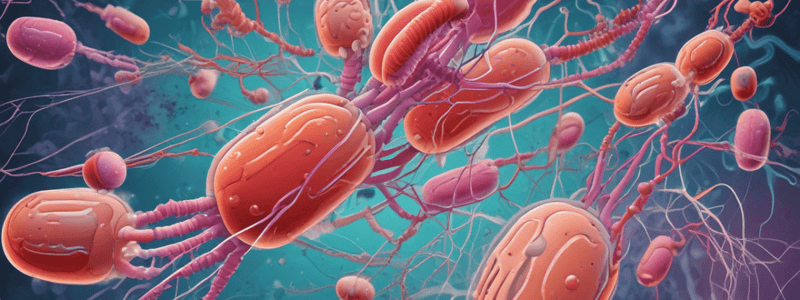Podcast
Questions and Answers
What is the primary species associated with disease in humans?
What is the primary species associated with disease in humans?
- A.nosocomialis
- A.baumannii (correct)
- Carbapenem-resistant Acinetobacter
- Acinetobacter
What is the main reason for the increasing importance of CRAB?
What is the main reason for the increasing importance of CRAB?
- The emergence of multidrug-resistant strains (correct)
- The capacity of CRAB to synthesize a variety of antibacterial resistance genes
- The frequency of CRAB infections in the community
- The ability of CRAB to persist on inanimate surfaces
What is the main objective of this article?
What is the main objective of this article?
- To explore the epidemiological features of CRAB
- To provide guidelines for the treatment of CRAB infections (correct)
- To compare the different guidelines for CRAB treatment
- To discuss the history of CRAB infections
What is the primary factor contributing to the survival of Acinetobacters?
What is the primary factor contributing to the survival of Acinetobacters?
What is necessary to improve patient outcomes in CRAB infections?
What is necessary to improve patient outcomes in CRAB infections?
What is the primary reason for the importance of surveillance in controlling CRAB nosocomial infections?
What is the primary reason for the importance of surveillance in controlling CRAB nosocomial infections?
What is the primary goal of deciphering the mechanisms of CRAB's drug resistance and pathogenicity?
What is the primary goal of deciphering the mechanisms of CRAB's drug resistance and pathogenicity?
What is the primary characteristic of CRAB that makes it difficult to treat?
What is the primary characteristic of CRAB that makes it difficult to treat?
What is the primary recommendation for the treatment of CRAB infections?
What is the primary recommendation for the treatment of CRAB infections?
What is the primary reason for the need to discuss how to manage CRAB more efficiently?
What is the primary reason for the need to discuss how to manage CRAB more efficiently?
What is the primary cause of pneumonia in critically ill patients, especially in those with prior exposure to antibiotics and H2 blockers?
What is the primary cause of pneumonia in critically ill patients, especially in those with prior exposure to antibiotics and H2 blockers?
Which of the following antibiotics are often overcrowded due to limited options for treating CRAB infections?
Which of the following antibiotics are often overcrowded due to limited options for treating CRAB infections?
What is the significance of the 2017 IDSA guidelines?
What is the significance of the 2017 IDSA guidelines?
Why are the IDSA guidelines on A.baumannii considered to be the hardest?
Why are the IDSA guidelines on A.baumannii considered to be the hardest?
What is the main limitation of the previous guidelines for treating CRAB infections?
What is the main limitation of the previous guidelines for treating CRAB infections?
What is the purpose of the study mentioned in the passage?
What is the purpose of the study mentioned in the passage?
What is the unified recommendation among ID societies for managing CRAB infections?
What is the unified recommendation among ID societies for managing CRAB infections?
What is the expected impact of the unified recommendation on managing CRAB infections?
What is the expected impact of the unified recommendation on managing CRAB infections?
What was the primary concern for the treatment of an extensively drug-resistant strain of A. baumannii in 2010?
What was the primary concern for the treatment of an extensively drug-resistant strain of A. baumannii in 2010?
What was the focus of the ESCMID guidelines?
What was the focus of the ESCMID guidelines?
What is the main reason for the difficulty in conducting randomized clinical trials for CRAB infections?
What is the main reason for the difficulty in conducting randomized clinical trials for CRAB infections?
What was the purpose of the comparative analysis of differing infectious guidelines for CRAB infections?
What was the purpose of the comparative analysis of differing infectious guidelines for CRAB infections?
What is the primary role of Acinetobacter in patients with ventilator pneumonia?
What is the primary role of Acinetobacter in patients with ventilator pneumonia?
What is the primary goal of effective antibiotic therapy for CRAB infections?
What is the primary goal of effective antibiotic therapy for CRAB infections?
What is the primary limitation of brilacidin for the treatment of superinfections?
What is the primary limitation of brilacidin for the treatment of superinfections?
What is the significance of the presence of lipopolysaccharides in the cell walls of Acinetobacter?
What is the significance of the presence of lipopolysaccharides in the cell walls of Acinetobacter?
What is the primary mode of spread of Acinetobacter baumannii in hospital settings?
What is the primary mode of spread of Acinetobacter baumannii in hospital settings?
What is the primary role of the IDSA guidelines for the treatment of CRAB infections?
What is the primary role of the IDSA guidelines for the treatment of CRAB infections?
What is the primary reason for the development of new guidelines for the treatment of CRAB infections?
What is the primary reason for the development of new guidelines for the treatment of CRAB infections?
What is the characteristic of Acinetobacter baumannii that makes it a significant therapeutic problem?
What is the characteristic of Acinetobacter baumannii that makes it a significant therapeutic problem?
What is the proportion of Acinetobacter baumannii strains that can survive in dry environments for more than a week?
What is the proportion of Acinetobacter baumannii strains that can survive in dry environments for more than a week?
What is the primary role of the PICO questions in the comparative analysis of guidelines?
What is the primary role of the PICO questions in the comparative analysis of guidelines?
What is the primary limitation of the ASHP guidelines for the treatment of CRAB infections?
What is the primary limitation of the ASHP guidelines for the treatment of CRAB infections?
What is the primary reason for comparing infectious disease guidelines?
What is the primary reason for comparing infectious disease guidelines?
What is the purpose of reviewing guidelines from different centers?
What is the purpose of reviewing guidelines from different centers?
What is the primary focus of the clinical practice guideline for CRAB infections?
What is the primary focus of the clinical practice guideline for CRAB infections?
What is the recommended duration of treatment for CRAB infections, except for FIDSA/ATS?
What is the recommended duration of treatment for CRAB infections, except for FIDSA/ATS?
What is the significance of nebulized colistin in the treatment of ventilator-associated bacterial pneumonia?
What is the significance of nebulized colistin in the treatment of ventilator-associated bacterial pneumonia?
What is the characteristic of the Acinetobacter group?
What is the characteristic of the Acinetobacter group?
What is the purpose of evaluating microbiological response using repeat cultures in patients with carbapenemase-producing A. baumannii infection?
What is the purpose of evaluating microbiological response using repeat cultures in patients with carbapenemase-producing A. baumannii infection?
What is the primary limitation of current guidelines for infectious disease treatment?
What is the primary limitation of current guidelines for infectious disease treatment?
Which of the following antibiotics is recommended by FIDSA/ATS for the treatment of CRAB infection due to its poorer treatment outcomes?
Which of the following antibiotics is recommended by FIDSA/ATS for the treatment of CRAB infection due to its poorer treatment outcomes?
What is the synergistic effect of combining tigecycline with which of the following antibiotics?
What is the synergistic effect of combining tigecycline with which of the following antibiotics?
Which of the following guidelines does not recommend consultation with an infectious disease specialist for the treatment of CRAB infection?
Which of the following guidelines does not recommend consultation with an infectious disease specialist for the treatment of CRAB infection?
What is the purpose of the comparative analysis of guidelines for CRAB infections and CRAB-associated sepsis?
What is the purpose of the comparative analysis of guidelines for CRAB infections and CRAB-associated sepsis?
What is the expected outcome of the findings from the cohort study on CRAB infection and CRAB sepsis guidelines?
What is the expected outcome of the findings from the cohort study on CRAB infection and CRAB sepsis guidelines?
What is the primary gap in the literature that this study addresses?
What is the primary gap in the literature that this study addresses?
What is the significance of establishing CRAB bacteremia as a definition for CRAB infection?
What is the significance of establishing CRAB bacteremia as a definition for CRAB infection?
Flashcards are hidden until you start studying
Study Notes
Carbapenem-Resistant Acinetobacter Baumannii (CRAB)
- CRAB is an increasing problem in healthcare settings, especially in patients with prior exposure to antibiotics and H2 blockers.
- Limited treatment options have led to overcrowding of colistin and tigecycline.
- The 2017 IDSA guidelines are the first recommendations specifically for CRAB infection.
Characteristics of Acinetobacter Baumannii
- Acinetobacter baumannii complex is an important group of bacteria that can cause hospital and community-based infections.
- A. baumannii is the primary species associated with disease in humans, and the clinical significance is increasing with the emergence of multidrug-resistant strains.
- It can survive on inanimate surfaces, resulting in nosocomial outbreaks.
- Surveillance and monitoring of multidrug-resistance are crucial in some geographical areas.
Antibiotic Therapy
- The IDSA guidelines recommend colistin, tigecycline, and meropenem/vaborbactam for the empirical treatment of healthcare-associated pneumonia due to CRAB.
- The use of effective antibiotic therapy is key to the eradication of CRAB infections.
- Clinical practice guidelines are important in the choice, duration, and dose of antibiotics.
Comparative Analysis of Guidelines
- A comparative analysis of differing infectious guidelines for CRAB infections has not been previously conducted.
- The duration of treatment for CRAB infections varies from 7-14 days, except for FIDSA/ATS, which recommends longer regimens for bacteremia or pneumonia.
- The use of combination therapy with enhanced dosing of aminoglycoside, tigecycline, or polymyxins has been recommended for CRAB colonization.
Conclusion and Future Directions
- The study highlights the need for a comprehensive comparison of CRAB infection guidelines to provide useful suggestions for clinical practice.
- There is a lack of agreement between the available guidelines, and future research is needed to establish a specific reference for the current clinical management of CRAB infection and CRAB sepsis.
Studying That Suits You
Use AI to generate personalized quizzes and flashcards to suit your learning preferences.




